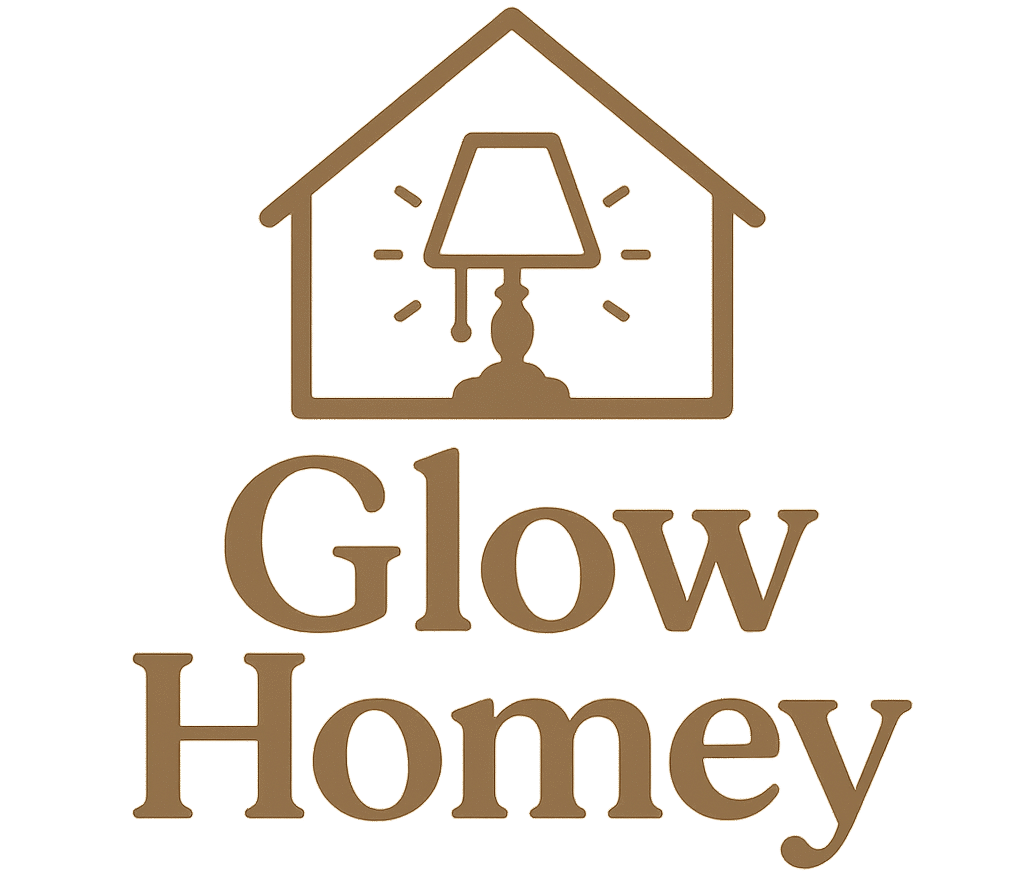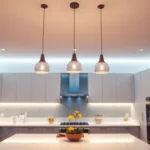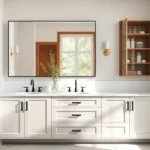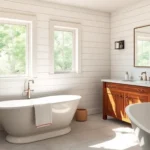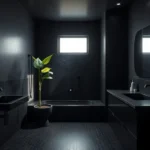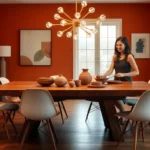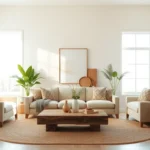We’ve all been there – staring at the same old bathroom tiles wondering if there’s something more exciting we could do with our walls. While traditional ceramic tiles have dominated bathroom design for decades, they’re certainly not our only option for creating a stunning and functional space.
Today’s homeowners are breaking free from conventional bathroom design rules and exploring creative alternatives that offer unique textures, colors, and visual appeal. From natural materials like wood and stone to modern options like waterproof wallpaper and decorative panels, the possibilities are endless.
Whether you’re renovating on a budget or simply want to create a bathroom that reflects your personal style, we’ll explore innovative wall treatments that are both practical and beautiful. These tile alternatives can transform your bathroom from ordinary to extraordinary while still providing the moisture resistance and durability you need.
Paint Options That Transform Your Bathroom Walls
Paint offers endless possibilities for creating stunning bathroom walls without the commitment of permanent tiles. We’ll explore specialized formulas and techniques that deliver both beauty and durability in moisture-rich environments.
Moisture-Resistant Paint Formulas
Bathroom-exact paints resist humidity and mold growth while maintaining their finish over time. We recommend semi-gloss or satin finishes because they repel moisture better than flat paints and clean easily with mild soap answers.
Epoxy-based paints provide exceptional water resistance for high-moisture areas like shower surrounds. These formulas create a hard, non-porous surface that prevents water penetration and withstands daily cleaning routines.
Antimicrobial paints contain built-in mold and mildew inhibitors that protect your walls from fungal growth. Brands like Benjamin Moore Aura Bath & Spa and Sherwin-Williams ProClassic offer these protective features without compromising color quality.
Primer selection determines paint performance in humid conditions. We suggest using high-quality moisture-blocking primers like Kilz Bathroom & Kitchen or Zinsser Cover Stain before applying your chosen topcoat.
Accent Wall Color Schemes
Bold navy blues create dramatic focal points behind vanities or freestanding tubs. Deep blues like Benjamin Moore Hale Navy or Sherwin-Williams Naval pair beautifully with white fixtures and brass hardware.
Warm sage greens bring natural tranquility to bathroom spaces while complementing both modern and traditional design styles. These earthy tones work especially well in bathrooms with natural wood elements or stone countertops.
Rich charcoal grays offer sophisticated alternatives to stark white walls. Colors like Farrow & Ball Railings or Clare Current Mood provide depth without overwhelming smaller bathroom spaces.
Soft blush pinks add warmth and femininity to powder rooms and guest bathrooms. These subtle hues reflect light beautifully and create inviting atmospheres for visitors.
Textured Paint Techniques
Sponge painting creates organic, cloud-like textures that hide minor wall imperfections while adding visual interest. We layer two or three complementary colors using natural sea sponges for the most authentic results.
Rag rolling produces elegant, fabric-like finishes that work particularly well in traditional bathroom designs. This technique involves rolling bunched rags through wet glaze to create soft, irregular patterns.
Stenciling allows you to add geometric patterns or botanical motifs without wallpaper. Moroccan-inspired designs and tropical leaf patterns are popular choices for creating feature walls behind vanities.
Faux finishing techniques like marbling or wood graining can mimic expensive materials at a fraction of the cost. These methods require practice but deliver stunning results that rival natural stone or hardwood appearances.
Natural Wood Paneling for Warmth and Style
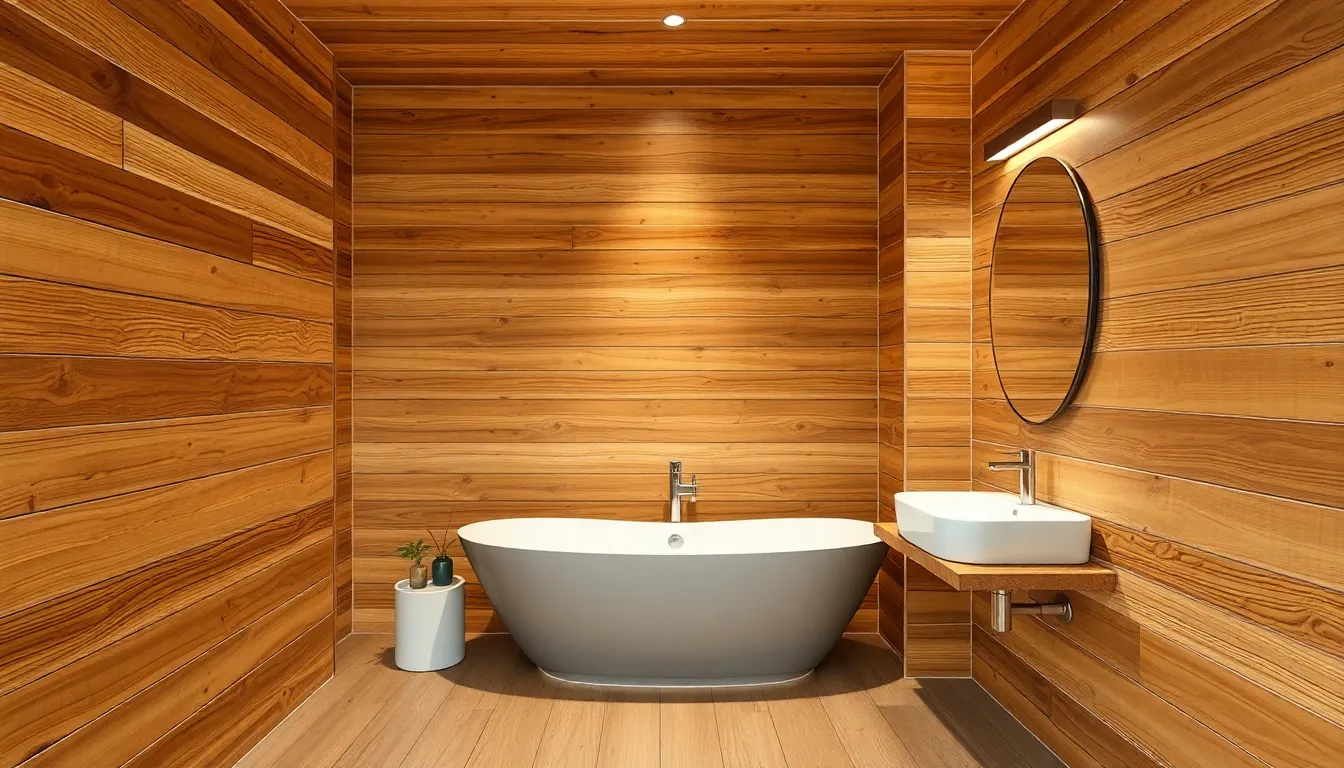
Wood paneling brings natural warmth and sophisticated style to bathroom spaces while creating a cozy ambiance that’s impossible to achieve with traditional tiles. We can transform any bathroom into a spa-like retreat using various wood finishes that complement different design aesthetics.
Reclaimed Wood Installation
Reclaimed wood offers a unique rustic appearance that adds character and eco-friendly appeal to bathroom walls. We recommend sourcing reclaimed barn wood, weathered fence panels, or salvaged flooring materials to create distinctive focal points. Proper installation requires securing the wood to moisture-resistant backing materials like cement board or waterproof drywall.
Planning the layout ensures optimal visual impact and structural integrity. We suggest measuring wall dimensions carefully and arranging wood pieces before installation to create balanced patterns. Installation typically involves using construction adhesive and finish nails to secure each piece, with careful attention to maintaining consistent spacing between boards.
Preparation steps include cleaning and sanding reclaimed materials to remove debris and splinters. We need to inspect each piece for structural soundness and treat any insect damage before installation. Proper sealing becomes crucial for preventing moisture infiltration and maintaining the wood’s integrity over time.
Waterproof Wood Treatment Options
Waterproof treatments protect wood panels from bathroom moisture while maintaining their natural beauty. We recommend marine-grade polyurethane finishes that create durable barriers against water damage and humidity. These treatments typically require multiple coats with light sanding between applications for optimal adhesion.
Penetrating sealers offer deep protection by soaking into wood fibers rather than sitting on the surface. We suggest using penetrating sealers on softer woods like pine or cedar, while harder woods like oak or maple benefit from surface treatments. Application involves brushing or rolling the sealer evenly across all wood surfaces, including edges and joints.
Regular maintenance preserves the effectiveness of waterproof treatments over time. We recommend reapplying protective coatings every 2-3 years or when water stops beading on the surface. Maintenance includes gentle cleaning with mild soap answers and avoiding harsh chemicals that can compromise the protective finish.
Shiplap and Tongue-and-Groove Designs
Shiplap designs provide sleek, modern aesthetics with horizontal lines that make bathrooms appear wider. We can install shiplap using various materials including cedar, pine, or engineered wood products designed for moisture-rich environments. The overlapping joint system creates natural expansion gaps that accommodate seasonal wood movement.
Tongue-and-groove installation creates seamless vertical or horizontal patterns without visible gaps. We recommend this technique for bathrooms requiring completely smooth surfaces that resist moisture infiltration. Installation requires precise cutting and fitting to ensure tight joints that won’t separate over time.
Both designs demand careful attention to wall preparation and leveling for professional results. We need to ensure walls are perfectly straight and properly primed before installation begins. Precise measurements and quality tools become essential for achieving the seamless finish that makes these designs so appealing in modern bathroom spaces.
Waterproof Wallpaper Patterns and Designs
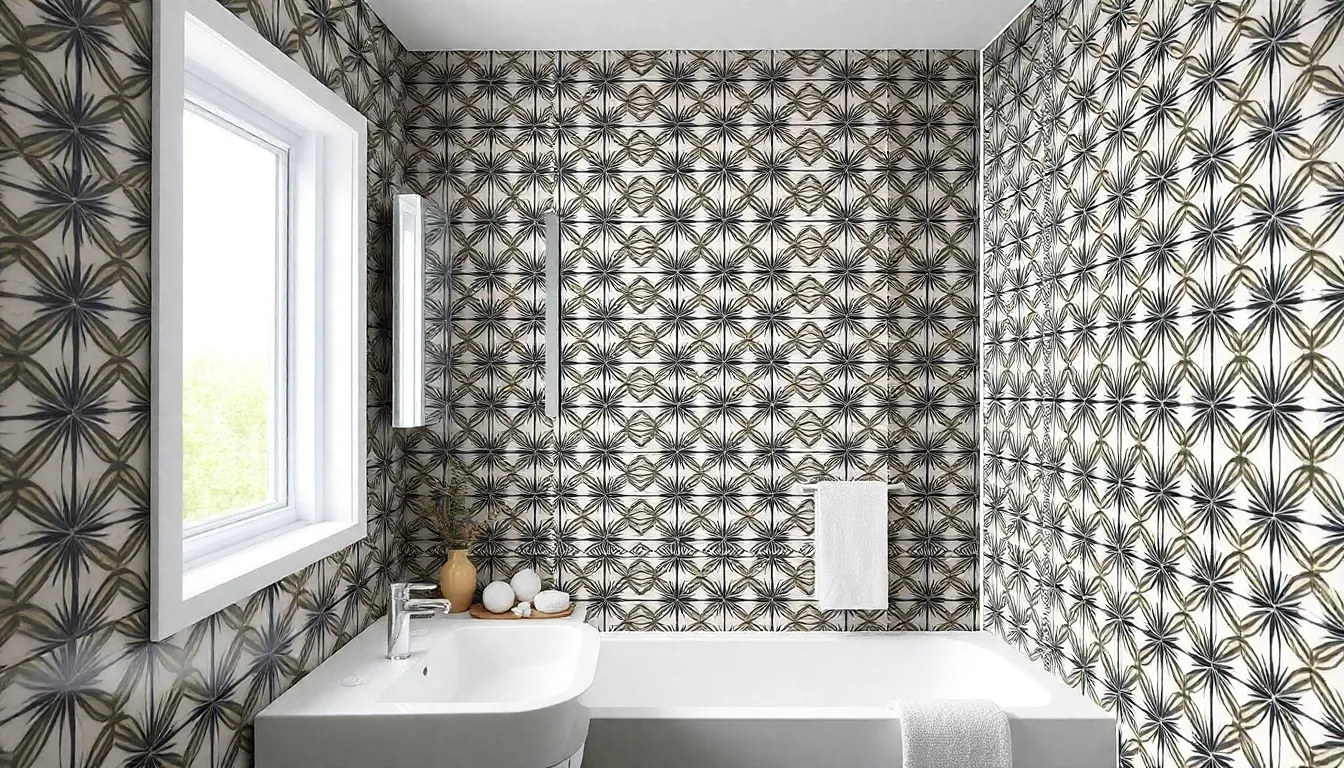
Modern bathroom wallpaper has evolved beyond traditional paper materials to include fully waterproof options that can transform your space. While these alternatives are less common than panels or natural materials, innovative waterproof wallpapers offer creative design possibilities for less humid areas or with proper moisture barriers.
Vinyl and PVC Wallpaper Options
Vinyl wallpapers provide the most durable waterproof solution for bathroom walls, featuring a plastic coating that repels moisture and steam effectively. These materials resist peeling and bubbling in humid conditions, making them suitable for powder rooms and half baths where direct water exposure is minimal.
PVC wallpapers offer superior water resistance compared to traditional vinyl options, with fully synthetic construction that prevents moisture penetration. We find these materials particularly effective when combined with proper ventilation systems and waterproof adhesives designed for bathroom applications.
Installation considerations require specialized moisture resistant adhesives and proper surface preparation to ensure long term performance. Professional installation often yields better results, especially in areas with moderate humidity levels where proper sealing is critical.
Peel-and-Stick Removable Wallpapers
Removable wallpaper options now include water resistant formulations that can withstand light moisture exposure while maintaining easy removal capabilities. These products work best in areas away from direct shower spray, such as behind vanities or on accent walls.
Self adhesive backing eliminates the need for traditional wallpaper paste, reducing installation time and complexity for DIY projects. Many modern peel and stick options feature repositionable adhesives that allow for adjustments during installation.
Temporary design answers make these wallpapers ideal for renters or homeowners who want to experiment with patterns without permanent commitment. We recommend testing adhesion in small areas first, especially in bathrooms with higher humidity levels.
Bold Patterns and Subtle Textures
Geometric patterns create striking focal points when applied to single accent walls, drawing attention away from utilitarian bathroom fixtures. Modern waterproof wallpapers feature everything from hexagonal designs to Art Deco inspired motifs that complement contemporary bathroom aesthetics.
Nature inspired textures including faux wood grain, stone patterns, and botanical prints can mimic expensive natural materials at a fraction of the cost. These designs work particularly well when paired with proper waterproofing measures in less humid bathroom areas.
Subtle textural elements like linen weaves, grasscloth effects, and embossed patterns add depth without overwhelming smaller bathroom spaces. We suggest choosing lighter colors and smaller scale patterns for compact bathrooms to maintain visual openness while adding design interest.
Stone and Brick Veneer Alternatives
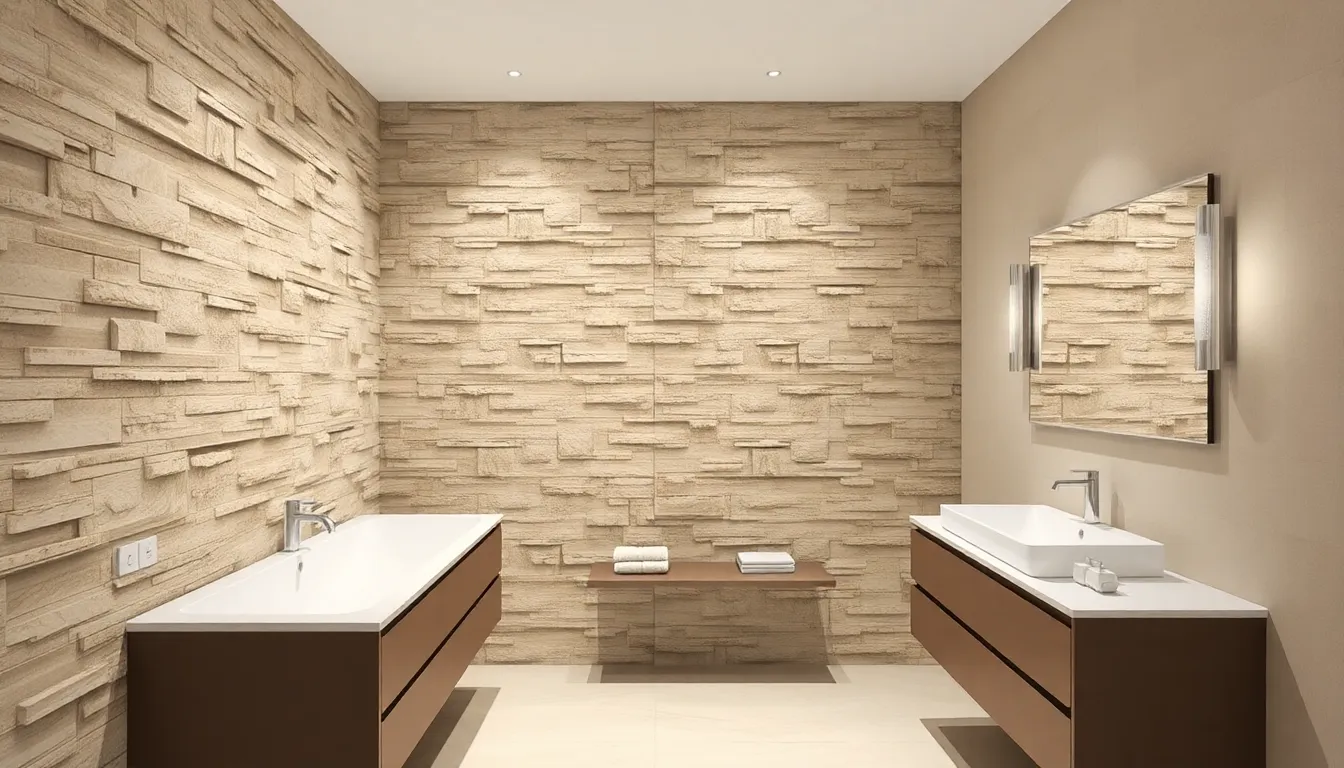
Stone and brick veneers deliver authentic textures without the weight and expense of full masonry construction. These thin slices of real or composite materials transform bathroom walls into stunning focal points while maintaining practical moisture resistance.
Faux Stone Panel Installation
Faux stone panels offer the quickest path to achieving a natural stone aesthetic in your bathroom. We recommend PVC, WPC, or laminate panels that perfectly mimic granite, limestone, or slate finishes without requiring specialized tools or expertise.
Installation becomes remarkably simple with these lightweight panels that cover large wall sections in minutes rather than hours. Most systems feature interlocking edges that eliminate the need for grout lines, reducing both installation time and ongoing maintenance requirements.
Coverage efficiency makes faux stone panels particularly attractive for budget conscious renovations. A single panel typically measures 48 by 32 inches, allowing you to transform an entire accent wall with just three or four pieces rather than hundreds of individual tiles.
Maintenance requirements drop significantly since these panels create seamless surfaces without grout joints that trap dirt and moisture. Regular cleaning requires only a damp cloth and mild detergent to maintain their appearance for years.
Exposed Brick Look Options
Brick effect panels provide the industrial charm of exposed masonry without structural modifications to your bathroom walls. These composite materials replicate authentic brick textures while offering superior moisture resistance compared to traditional clay bricks.
PVC and acrylic brick panels deliver lightweight answers that won’t stress your wall framing or require additional structural support. We’ve seen installations completed in single afternoons using standard construction adhesive and basic cutting tools.
Brick veneer applications allow you to use thin slices of genuine brick for the most authentic appearance possible. These products maintain the natural color variations and weathered textures that make exposed brick so appealing in modern bathroom designs.
Accent wall configurations work particularly well with brick alternatives, creating focal points behind vanities or in shower areas. The key lies in balancing the rustic brick texture with sleek fixtures and modern lighting to achieve contemporary appeal.
Natural Stone Accent Features
Natural stone cladding introduces unmatched elegance through materials like Kota stone, limestone, and slate that bring earthy sophistication to bathroom spaces. These genuine stone options create unique textures and color variations that synthetic alternatives cannot replicate.
Slate installations provide naturally slip resistant surfaces with rich, dark tones that complement both traditional and contemporary design schemes. We typically recommend slate for shower walls where its natural water resistance becomes a important practical advantage.
Limestone applications offer warm, neutral tones that brighten bathroom spaces while maintaining the substantial feel of natural stone. Proper sealing prevents staining and water damage, ensuring your limestone accent walls remain beautiful for decades.
Installation considerations for natural stone require professional assessment of your wall structure since genuine stone weighs significantly more than synthetic alternatives. Most installations benefit from additional wall reinforcement and specialized mounting systems designed for heavy materials.
Glass Panel Solutions for Modern Bathrooms
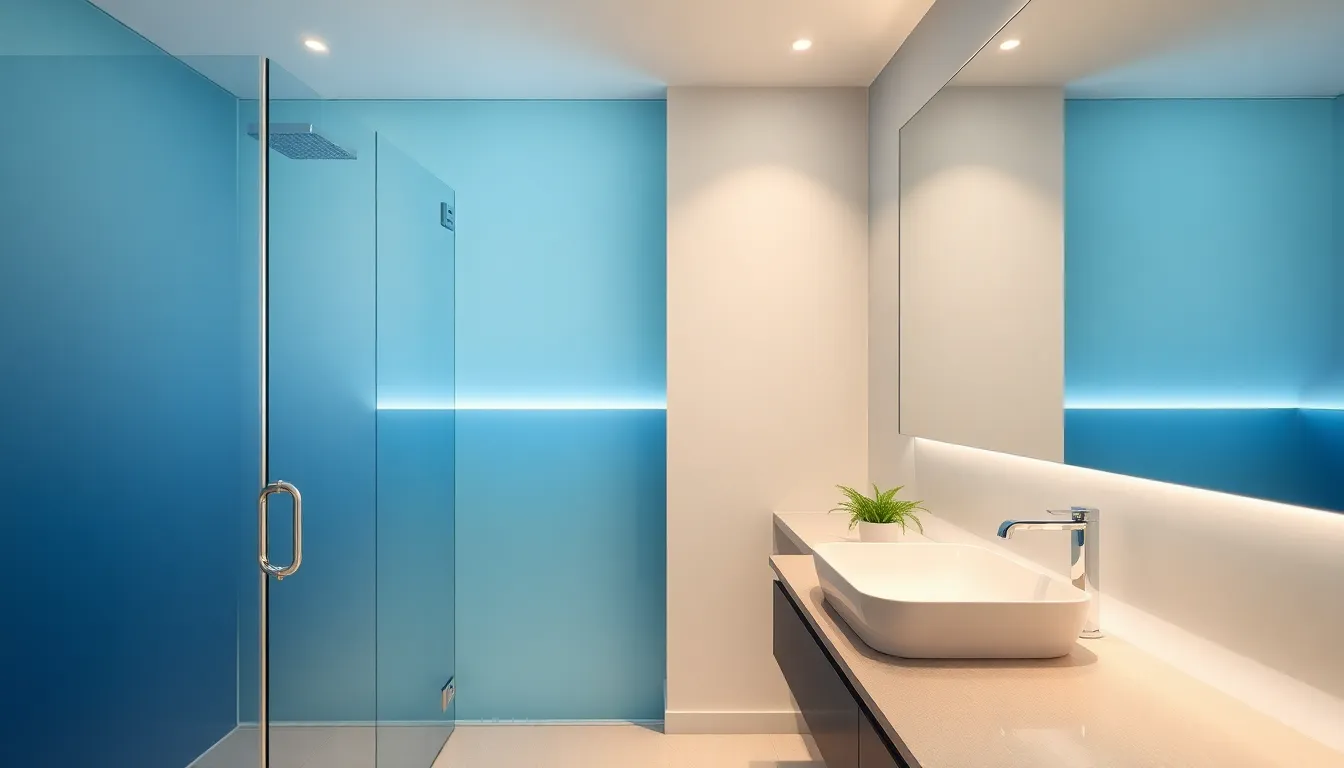
Glass panels offer sleek, moisture-resistant alternatives that require no grout maintenance while providing customizable design options. We’ll explore three popular glass panel answers that can transform your bathroom walls.
Frosted Glass Privacy Panels
Frosted glass panels create privacy while maintaining natural light flow throughout your bathroom space. These panels work exceptionally well in shower enclosures where you need visual separation without blocking illumination. We recommend installing frosted glass panels on vanity walls to eliminate the need for window treatments while preserving your privacy.
Patterns vary from subtle etched designs to bold geometric shapes that complement contemporary bathroom aesthetics. Opacity levels range from lightly frosted options that allow shadows to pass through to completely opaque panels that block all visibility. Installing these panels requires waterproof adhesive systems and professional mounting to ensure long-term durability.
Colored Glass Backsplash Ideas
Colored glass backsplashes provide waterproof surfaces that resist moisture while adding vibrant visual interest behind sinks and showers. We suggest matching glass colors to your existing fixtures for a cohesive look or creating contrast with complementary hues. Maintenance involves simple wiping with standard glass cleaners, making these backsplashes practical for daily use.
Popular color options include deep blues that evoke spa-like tranquility, emerald greens that bring natural elements indoors, and warm amber tones that create cozy atmospheres. Textured colored glass adds depth through subtle surface variations while maintaining the smooth, easy-to-clean properties of standard glass panels. Custom color matching allows you to coordinate with paint colors, countertops, or decorative accessories throughout your bathroom.
Mirror Panel Installations
Mirror panels visually expand small bathrooms while serving as durable, wipeable wall surfaces that reflect light throughout the space. Large seamless mirror panels create uninterrupted reflective surfaces that make bathrooms appear significantly larger than their actual dimensions. We recommend installing mirror panels over waterproof substrates to prevent moisture damage behind the mirrors.
Modular mirror sections offer flexibility in design while simplifying installation and potential replacement needs. These panels come in various sizes that can be arranged in grid patterns or offset configurations to create unique wall treatments. Professional installation ensures proper mounting systems that can support the weight of large mirror panels while providing secure attachment to bathroom walls.
Metal Wall Covering Ideas
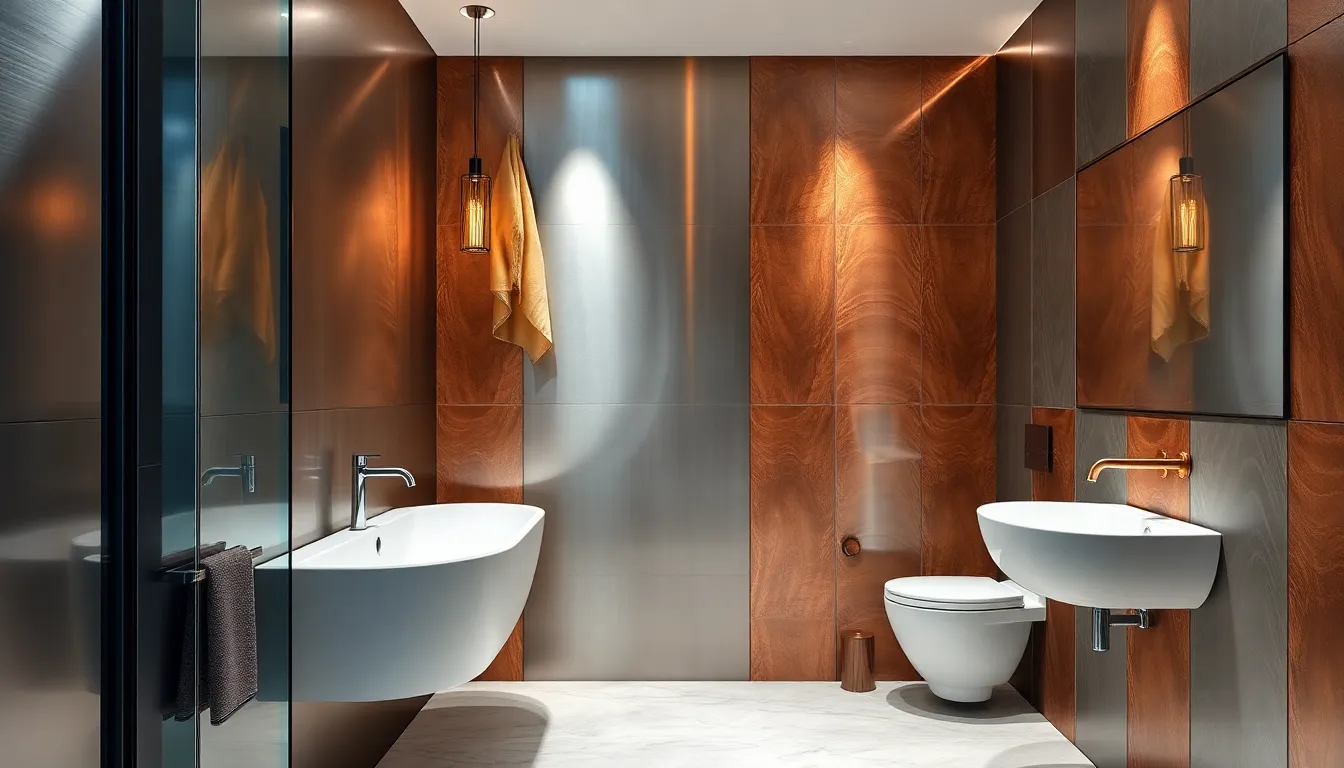
Metal wall coverings bring industrial sophistication and modern elegance to bathroom spaces. These materials offer unique aesthetic possibilities while providing excellent durability and water resistance when properly installed.
Stainless Steel Sheet Applications
Stainless steel decorative panels create a sleek, contemporary look that complements modern bathroom designs. We recommend these panels for their lightweight properties and exceptional resistance to chemicals commonly found in bathroom cleaning products. Professional installation ensures proper seam sealing with high-quality caulk to prevent water infiltration and mold growth.
Maintenance of stainless steel surfaces requires regular cleaning with specialized products to prevent water spots and fingerprints. Brushed finishes hide minor scratches better than polished surfaces, making them ideal for high-traffic family bathrooms. These panels work exceptionally well behind vanities or as shower surrounds when combined with proper waterproofing membranes.
Copper and Bronze Accent Panels
Copper accent panels add luxurious warmth and sophisticated character to bathroom walls. These materials develop a natural patina over time, creating unique visual interest that evolves with your space. Regular maintenance prevents excessive oxidation while preserving the desired aesthetic appearance.
Bronze panels offer similar luxury appeal with enhanced durability compared to pure copper options. We suggest using these metals strategically as accent features rather than full wall coverage to maximize visual impact while controlling costs. Professional installation ensures proper ventilation behind panels to prevent moisture buildup.
Both materials require protective coatings specifically designed for bathroom environments to maintain their appearance and prevent corrosion. Periodic reapplication of these coatings extends the lifespan of your investment while preserving the metal’s distinctive character.
Corrugated Metal Industrial Looks
Corrugated metal panels deliver bold industrial styling that transforms ordinary bathrooms into contemporary design statements. These panels require additional water-resistant coatings to perform effectively in high-moisture environments. We recommend galvanized or powder-coated options for enhanced durability and corrosion resistance.
Installation techniques for corrugated panels differ from flat metal applications due to their textured surface profile. Proper spacing and ventilation behind panels prevents condensation buildup that could lead to structural issues. These panels work particularly well in powder rooms or half baths where moisture exposure is more limited.
Color options for corrugated metal extend beyond traditional silver tones to include blacks, whites, and custom powder-coated finishes. Strategic lighting placement enhances the dimensional qualities of corrugated surfaces, creating dramatic shadows and highlights that add visual depth to your bathroom space.
Fabric and Textile Wall Treatments
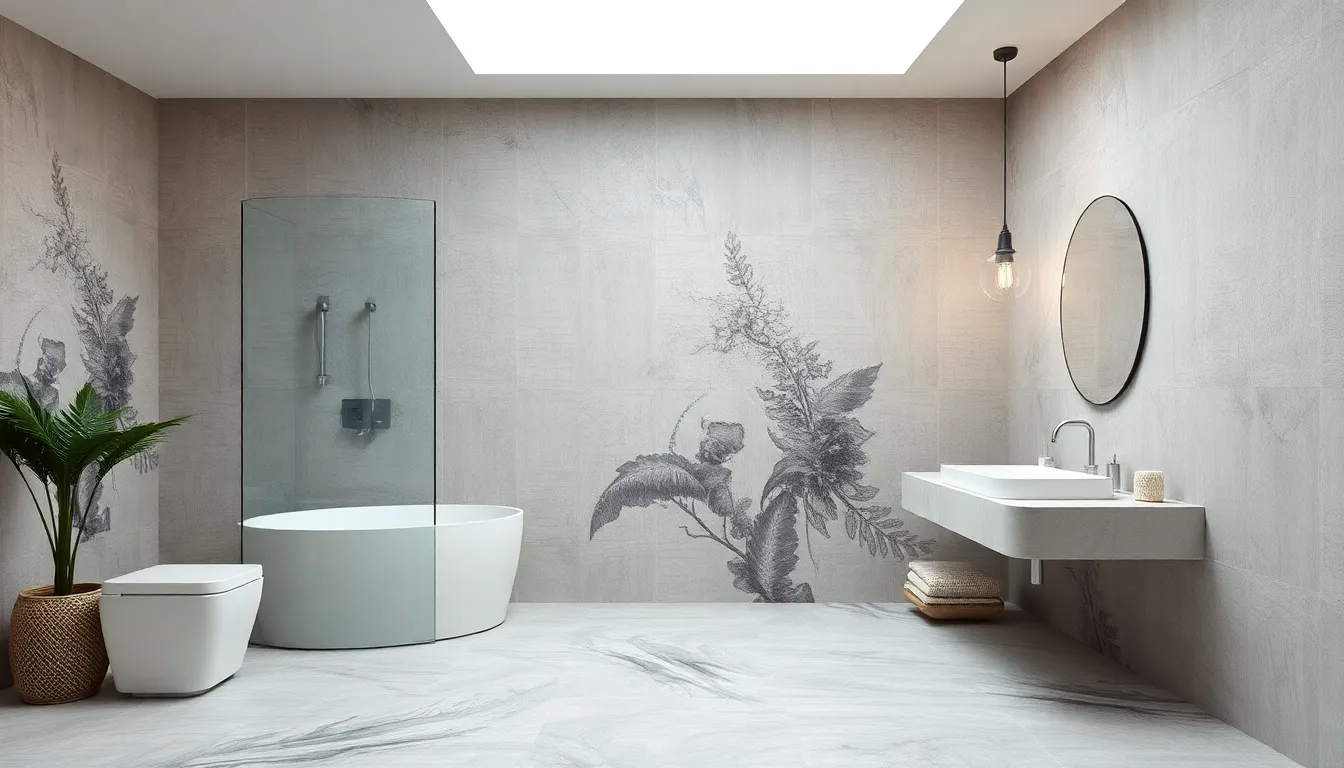
Moving beyond hard surfaces, we can achieve the soft comfort of fabric in bathroom spaces through innovative waterproof answers. These textile inspired options offer design flexibility while maintaining the moisture resistance essential for bathroom environments.
Waterproof Fabric Panel Systems
Waterproof fabric panels deliver textile aesthetics without moisture concerns. Several manufacturers now produce fabric-look panels made from PVC, acrylic, or laminate materials that simulate authentic fabric textures and canvas appearances. These engineered panels resist moisture, mildew, and stains while installing quickly across entire bathroom or shower walls.
Installation becomes straightforward with most panel systems. We can complete full wall coverage in hours rather than days, making these panels ideal for quick bathroom renovations. The panels come in various patterns and finishes, from subtle linen textures to bold geometric fabric designs.
Maintenance stays minimal with these waterproof alternatives. Cleaning requires only simple wiping with standard bathroom cleaners, and the panels won’t absorb odors or harbor bacteria like traditional fabric would.
Canvas and Vinyl Wall Coverings
Vinyl wall coverings provide durable fabric simulation for bathroom walls. Heavy duty and commercial grade vinyl can be printed to mimic fabric textures, canvas weaves, or even stone and wood patterns. These coverings offer water resistance and easy cleaning, though they’re less durable against physical abrasion compared to rigid panels.
Canvas style vinyl creates artistic appeal in bathroom spaces. This popular option delivers a soft, textured appearance while maintaining full functionality in moisture rich environments. We can apply these coverings to create feature walls or cover entire bathroom spaces.
Professional installation ensures optimal performance. Proper surface preparation and adhesive application prevent peeling and water infiltration, extending the life of vinyl wall coverings in bathroom applications.
Removable Fabric Installation Methods
Removable fabric panels offer temporary design answers. Adhesive backed fabric panels and peel and stick wallpapers with waterproof topcoats provide simple application and removal options. These products work perfectly for renters or homeowners seeking seasonal bathroom updates.
Quick installation makes these methods appealing. We can transform bathroom walls in minutes without tools or professional help, making removable options ideal for frequent design changes.
Limited moisture resistance restricts placement options. While suitable for low moisture areas and feature walls, these removable answers aren’t recommended for high moisture zones like shower surrounds. Their performance in steam heavy environments remains limited compared to permanent waterproof alternatives.
Creative Concrete and Plaster Finishes

Raw materials like concrete and plaster offer sophisticated bathroom wall answers that rival traditional tiles. Modern application techniques transform these industrial materials into luxurious finishes.
Venetian Plaster Techniques
Venetian plaster creates a smooth, marble-like finish through strategic layering of thin plaster coats. This ancient technique delivers the luxurious appearance of natural marble without the expense or weight concerns. We apply multiple translucent layers that build depth and luminosity, creating surfaces that seem to glow from within.
Professional application requires exact troweling motions to achieve the signature polished appearance. Each layer must cure properly before applying subsequent coats, typically taking 4-6 hours between applications. We recommend hiring experienced plasterers for best results, as the technique demands precision and timing.
Color variations emerge through tinted base coats and metallic wax finishes that enhance the natural marble appearance. Popular bathroom combinations include warm cream bases with gold highlights or cool gray foundations with silver accents. These finishes resist moisture when properly sealed with specialized topcoats.
Concrete Panel Applications
Concrete panels provide versatile finishing options with various textures and colors for modern industrial aesthetics. These panels offer the durability of traditional concrete while remaining lightweight enough for standard wall installation. We can achieve smooth contemporary surfaces or textured rustic appearances depending on the panel manufacturing process.
Installation involves standard mounting systems that secure panels directly to wall studs or existing surfaces. Most concrete panels measure 4×8 feet and weigh approximately 40-60 pounds, making them manageable for two-person installation teams. Surface preparation requires level walls and appropriate moisture barriers behind the panels.
Finishing techniques include staining, painting, or sealing to customize the final appearance and enhance moisture resistance. Penetrating sealers protect the concrete from water damage while maintaining the natural texture. We recommend applying sealers every 2-3 years in high-moisture bathroom environments.
Textured Stucco Alternatives
Textured stucco delivers unique visual interest through various application patterns and finishing techniques. Modern synthetic stucco formulations resist moisture better than traditional lime-based versions, making them suitable for bathroom applications. We can create smooth Venetian-style finishes or heavily textured Mediterranean appearances.
Application methods include troweling, brushing, and sponging to achieve different surface textures and visual effects. Skip trowel techniques create subtle texture variations, while knockdown methods produce flatter surfaces with organic patterns. Each technique requires different drying times and tool selection for optimal results.
Durability depends on proper surface preparation and moisture management systems behind the stucco application. We recommend installing vapor barriers and ensuring adequate ventilation to prevent moisture buildup. Regular maintenance involves inspecting for cracks and resealing as needed to maintain water resistance.
Modern Laminate and Composite Materials
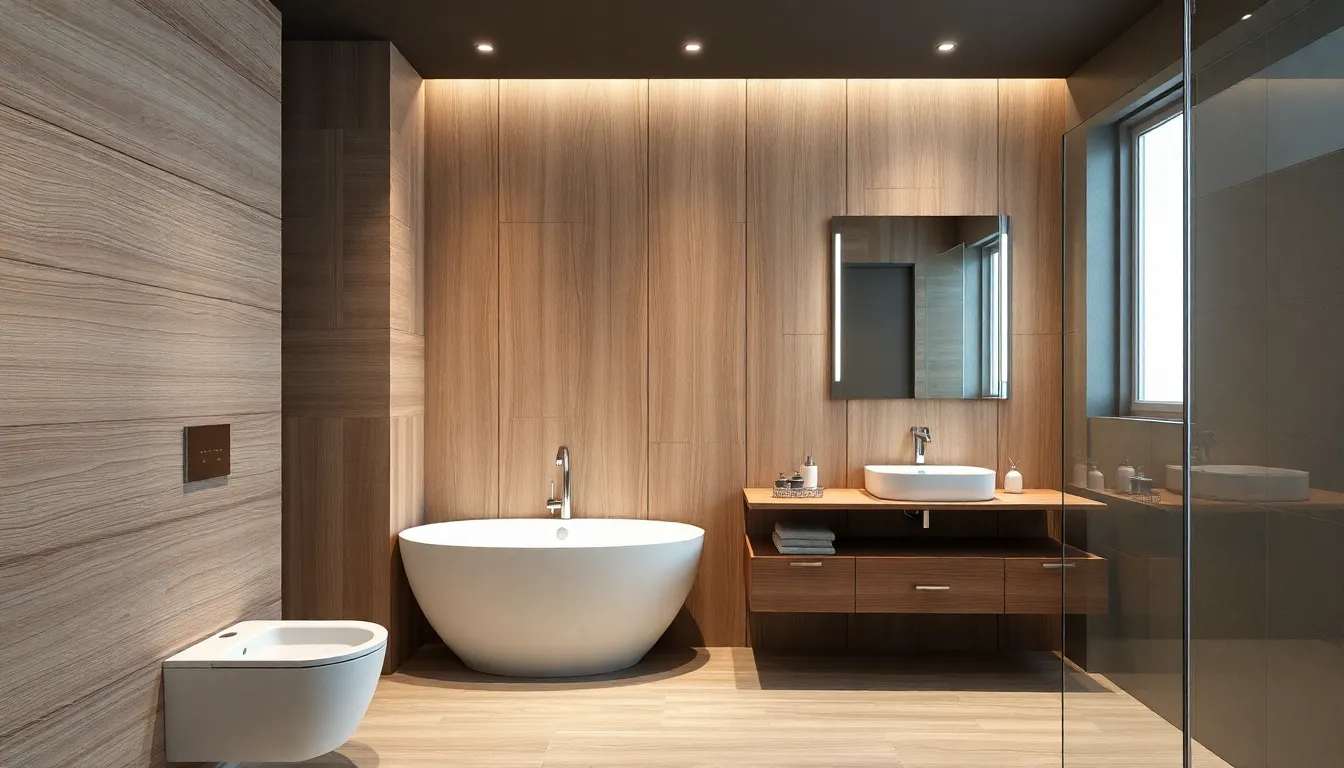
Today’s bathroom design evolution includes sophisticated engineered materials that deliver the aesthetics you want with enhanced performance. These advanced options combine durability with style while offering simplified installation processes.
High-Pressure Laminate Sheets
High-pressure laminate sheets represent one of the most versatile wall covering answers we can recommend for modern bathrooms. These engineered materials withstand water exposure exceptionally well while resisting stains, scratches, and daily wear. Their durability makes them ideal for high-traffic family bathrooms where maintenance needs to stay minimal.
Installation involves securing these sheets directly to properly prepared wall surfaces using construction adhesive or mechanical fasteners. We’ve found that their versatility in design allows homeowners to achieve looks ranging from natural wood grains to contemporary solid colors. The waterproof nature of these laminates eliminates concerns about moisture damage that traditional materials often face.
Cleaning becomes remarkably simple with these surfaces, requiring only standard household cleaners and a soft cloth. Their smooth finish prevents mold and mildew buildup, making them particularly suitable for shower areas and high-humidity zones.
Composite Panel Systems
Composite panel systems combine different materials to create exceptionally strong and durable bathroom wall answers. These engineered products typically integrate PVC, WPC, or laminate components to deliver superior performance characteristics. Their strength comes from this multi-material construction that resists warping, cracking, and moisture penetration.
Modern composite panels provide sleek, contemporary aesthetics that complement today’s bathroom design trends. We appreciate how these systems can mimic natural materials like stone, concrete, or wood without requiring extensive maintenance protocols. Their molded construction allows for consistent thickness and seamless joints when properly installed.
Professional installation ensures optimal performance, though many composite systems feature user-friendly mounting mechanisms. These panels typically attach to wall framing or backing boards using specialized clips or adhesive systems designed for bathroom environments.
Easy-Install Click-Lock Options
Easy-install click-lock systems revolutionize bathroom wall renovation by eliminating complex installation procedures. These innovative panels feature interlocking edges that snap together securely without requiring grout lines or extensive wall preparation. Quick installation means we can complete most bathroom wall projects in significantly less time than traditional methods.
Click-lock technology reduces the tools needed for installation, often requiring only basic cutting implements and measuring equipment. Many systems install directly over existing wall surfaces, saving demolition time and associated mess. Their tongue-and-groove or similar connection methods create water-tight seals that prevent moisture infiltration.
Maintenance stays minimal with these systems since their seamless surfaces resist dirt accumulation and bacterial growth. We find that their modular design also allows for easy replacement of individual panels if damage occurs, extending the overall lifespan of the installation.
Conclusion
We’ve shown you that bathroom walls don’t have to be limited to traditional ceramic tiles. From waterproof wallpaper and natural wood paneling to modern glass panels and industrial metal coverings there’s a solution for every design preference and budget.
The key is choosing materials that balance aesthetics with functionality while considering your bathroom’s moisture levels and maintenance requirements. Whether you prefer the warmth of wood the sophistication of Venetian plaster or the durability of high-pressure laminate each option offers unique benefits that can transform your space.
These innovative wall treatments prove that with the right materials and techniques you can create a bathroom that’s both beautiful and practical. Start exploring these alternatives today and discover how they can elevate your bathroom’s design beyond conventional expectations.
Frequently Asked Questions
What are the best alternatives to ceramic tiles for bathroom walls?
Popular alternatives include natural wood paneling, waterproof wallpaper, stone veneer panels, glass solutions, and specialized moisture-resistant paints. These options offer unique textures, colors, and design flexibility while maintaining the durability needed for bathroom environments.
Can I use regular paint in my bathroom?
No, regular paint isn’t suitable for bathrooms. Use moisture-resistant paints with semi-gloss or satin finishes, epoxy-based formulas, or antimicrobial paints specifically designed for high-humidity areas. Always apply a high-quality primer first for optimal performance.
Is wood paneling safe for bathroom use?
Yes, when properly treated. Use marine-grade polyurethane finishes or penetrating sealers to protect wood from moisture. Reclaimed wood, shiplap, and tongue-and-groove designs work well when waterproofed correctly and installed with proper ventilation.
How durable is waterproof wallpaper in bathrooms?
Modern waterproof wallpapers made from vinyl or PVC are highly durable and designed to withstand bathroom humidity. Peel-and-stick removable options are perfect for renters, while traditional waterproof wallpapers offer long-term solutions with bold patterns and textures.
Are stone and brick veneer panels easy to install?
Yes, faux stone panels made from PVC, WPC, or laminate are lightweight and easy to install with minimal tools. They provide authentic textures without the weight of real masonry. However, natural stone cladding requires professional installation due to weight considerations.
What maintenance do glass panels require in bathrooms?
Glass panels are low-maintenance and easy to clean with standard glass cleaners. Frosted glass offers privacy, colored glass creates artistic backsplashes, and mirror panels enhance light reflection. All options resist moisture and maintain their appearance with regular cleaning.
Can metal wall coverings work in humid bathroom environments?
Yes, metals like stainless steel, copper, and bronze are excellent for bathrooms when properly sealed. Stainless steel offers durability, copper develops attractive patina, and corrugated metal provides industrial styling. Regular cleaning prevents water spots and maintains their appearance.
Are fabric wall treatments practical for bathrooms?
Modern waterproof fabric panels made from PVC or acrylic simulate textile textures while resisting moisture. Vinyl wall coverings that mimic fabric patterns offer durability and artistic appeal. However, traditional fabric installations have limited moisture resistance and aren’t recommended for wet areas.
How do concrete and plaster finishes perform in bathrooms?
Venetian plaster creates luxurious marble-like surfaces but requires professional application. Concrete panels offer versatility with various textures and colors while remaining lightweight. Modern synthetic stucco formulations resist moisture and can be applied in unique patterns for sophisticated finishes.
What are the benefits of laminate and composite materials for bathroom walls?
High-pressure laminate sheets resist water, stains, and scratches while offering numerous design options. Composite panel systems combine materials for enhanced strength and moisture resistance. Click-lock installation systems make renovation quick and easy with minimal maintenance requirements.
